Page 120 of 162
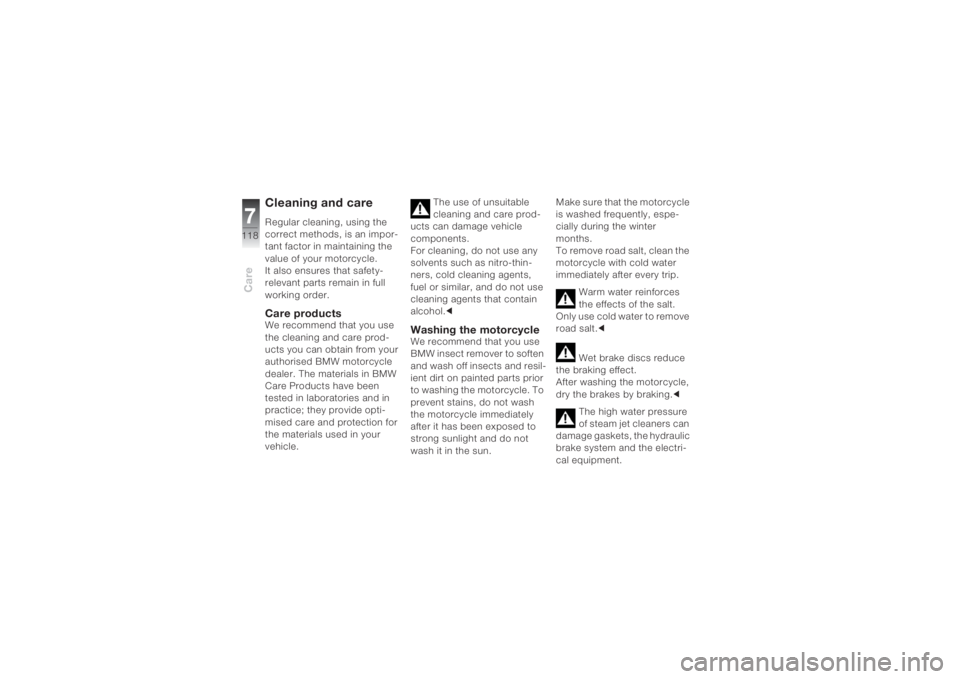
Care7118
Cleaning and care Regular cleaning, using the
correct methods, is an impor-
tant factor in maintaining the
value of your motorcycle.
It also ensures that safety-
relevant parts remain in full
working order.Care productsWe recommend that you use
the cleaning and care prod-
ucts you can obtain from your
authorised BMW motorcycle
dealer. The materials in BMW
Care Products have been
tested in laboratories and in
practice; they provide opti-
mised care and protection for
the materials used in your
vehicle. The use of unsuitable
cleaning and care prod-
ucts can damage vehicle
components.
For cleaning, do not use any
solvents such as nitro-thin-
ners, cold cleaning agents,
fuel or similar, and do not use
cleaning agents that contain
alcohol.c
Washing the motorcycleWe recommend that you use
BMW insect remover to soften
and wash off insects and resil-
ient dirt on painted parts prior
to washing the motorcycle. To
prevent stains, do not wash
the motorcycle immediately
after it has been exposed to
strong sunlight and do not
wash it in the sun.Make sure that the motorcycle
is washed frequently, espe-
cially during the winter
months.
To remove road salt, clean the
motorcycle with cold water
immediately after every trip.
Warm water reinforces
the effects of the salt.
Only use cold water to remove
road salt.c
Wet brake discs reduce
the braking effect.
After washing the motorcycle,
dry the brakes by braking.c
The high water pressure
of steam jet cleaners can
damage gaskets, the hydraulic
brake system and the electri-
cal equipment.
Page 121 of 162
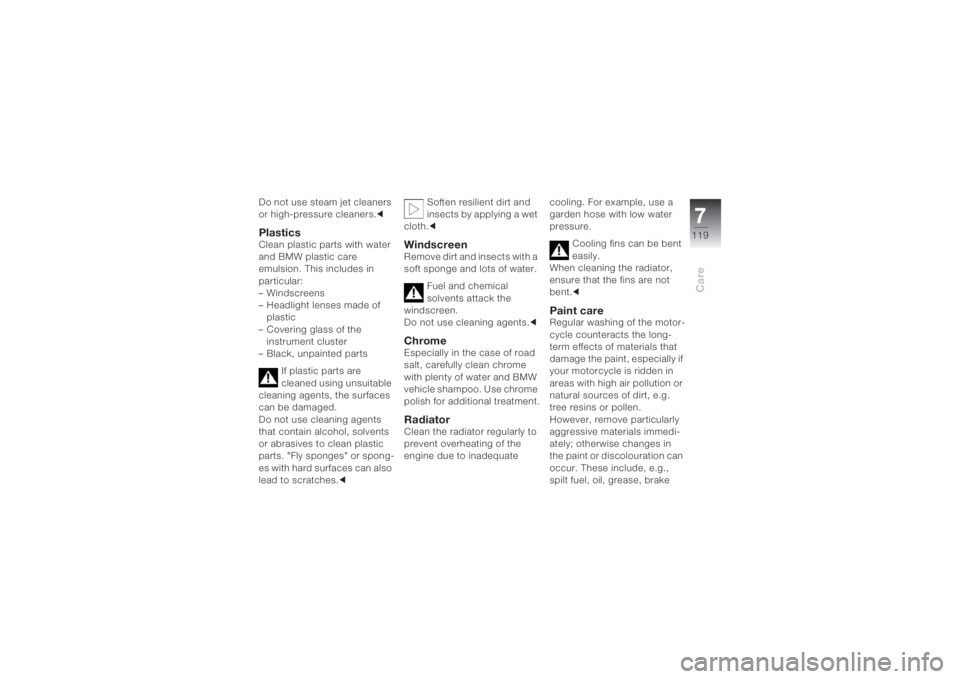
7119
Care
Do not use steam jet cleaners
or high-pressure cleaners.cPlasticsClean plastic parts with water
and BMW plastic care
emulsion. This includes in
particular:
– Windscreens
– Headlight lenses made of
plastic
– Covering glass of the
instrument cluster
– Black, unpainted parts
If plastic parts are
cleaned using unsuitable
cleaning agents, the surfaces
can be damaged.
Do not use cleaning agents
that contain alcohol, solvents
or abrasives to clean plastic
parts. "Fly sponges" or spong-
es with hard surfaces can also
lead to scratches.cSoften resilient dirt and
insects by applying a wet
cloth.c
WindscreenRemove dirt and insects with a
soft sponge and lots of water.
Fuel and chemical
solvents attack the
windscreen.
Do not use cleaning agents.cChromeEspecially in the case of road
salt, carefully clean chrome
with plenty of water and BMW
vehicle shampoo. Use chrome
polish for additional treatment.RadiatorClean the radiator regularly to
prevent overheating of the
engine due to inadequate cooling. For example, use a
garden hose with low water
pressure.
Cooling fins can be bent
easily.
When cleaning the radiator,
ensure that the fins are not
bent.c
Paint careRegular washing of the motor-
cycle counteracts the long-
term effects of materials that
damage the paint, especially if
your motorcycle is ridden in
areas with high air pollution or
natural sources of dirt, e.g.
tree resins or pollen.
However, remove particularly
aggressive materials immedi-
ately; otherwise changes in
the paint or discolouration can
occur. These include, e.g.,
spilt fuel, oil, grease, brake
Page 126 of 162
Technical data8124
Bolt connections Activity Type of bolt connectionTightening
torqueFront wheel
Mudguard Internal TORX
® T25 (1) hand-tight
Brake caliper Internal TORX® T45 30 Nm
Axle clamping screw Internal TORX® T40 19 Nm
Quick-release axle Allen screw w/f 22 50 Nm
Rear wheel
Clip cover Internal TORX® T25 (1) hand-tight
End silencer to footrest Internal TORX® T45 16 Nm
Clamp on end silencer Internal TORX® T45 35 Nm
Rear wheel Internal TORX® T50 60 Nm
Lamp housing
Brake and rear light Phillips screw, large (1) hand-tight
Front turn indicators Phillips screw, large (1) hand-tight
Rear turn indicators Phillips screw, small (1) hand-tight
Page 131 of 162
8129
Technical data
Frame and suspension Frame
Type Main and rear frame in light-alloy design
Location of type plate on the rear cross frame tube
Location of vehicle identification number (VIN) on the side frame section at the front right
Front brake
Type two floating brake discs
with 4-piston fixed calipers
sintered metal brake pads
Rear brake
Type one fixed brake disc with 2-piston floating
caliper
organic brake pads
Front wheel guide
Type BMW Duolever
Steering lock angle 2 x 29
o
Front wheel castor in normal-load position 111.63 mm
Rear wheel guide
Type BMW EVO Paralever swinging arm
Page 138 of 162
Technical data8136
Electrical systemBulbs
Design of headlight Clear glass with three reflectors
High-beam headlight 2 H7 halogen bulbs, 12 V 55 W
Low-beam headlight H7 halogen bulb 12 V 55 W
Parking light 12 V 5 W
Brake/rear lights 12 V 21/5 W
Front turn indicators 12 V 16 W
Rear flashing turn indicators 12 V 10 W
Power socket
Ratings 12 V 5 A
Page 151 of 162
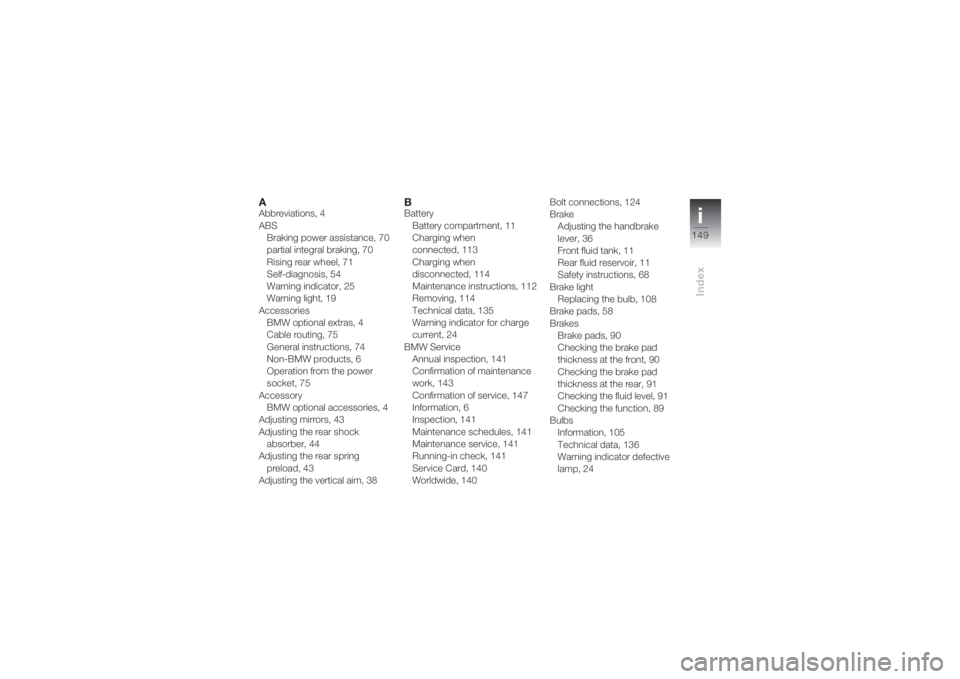
i149
Index
AAbbreviations, 4
ABS
Braking power assistance, 70
partial integral braking, 70
Rising rear wheel, 71
Self-diagnosis, 54
Warning indicator, 25
Warning light, 19
Accessories
BMW optional extras, 4
Cable routing, 75
General instructions, 74
Non-BMW products, 6
Operation from the power
socket, 75
Accessory
BMW optional accessories, 4
Adjusting mirrors, 43
Adjusting the rear shock
absorber, 44
Adjusting the rear spring
preload, 43
Adjusting the vertical aim, 38
BBattery
Battery compartment, 11
Charging when
connected, 113
Charging when
disconnected, 114
Maintenance instructions, 112
Removing, 114
Technical data, 135
Warning indicator for charge
current, 24
BMW Service
Annual inspection, 141
Confirmation of maintenance
work, 143
Confirmation of service, 147
Information, 6
Inspection, 141
Maintenance schedules, 141
Maintenance service, 141
Running-in check, 141
Service Card, 140
Worldwide, 140Bolt connections, 124
Brake
Adjusting the handbrake
lever, 36
Front fluid tank, 11
Rear fluid reservoir, 11
Safety instructions, 68
Brake light
Replacing the bulb, 108
Brake pads, 58
Brakes
Brake pads, 90
Checking the brake pad
thickness at the front, 90
Checking the brake pad
thickness at the rear, 91
Checking the fluid level, 91
Checking the function, 89
Bulbs
Information, 105
Technical data, 136
Warning indicator defective
lamp, 24
Page 154 of 162
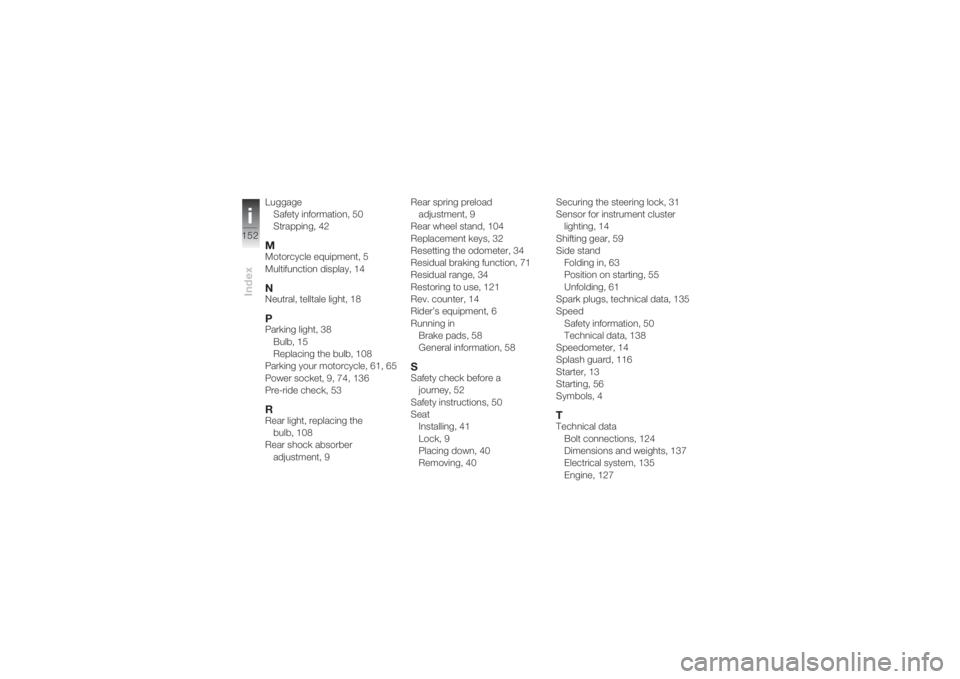
Indexi152
Luggage
Safety information, 50
Strapping, 42MMotorcycle equipment, 5
Multifunction display, 14NNeutral, telltale light, 18PParking light, 38
Bulb, 15
Replacing the bulb, 108
Parking your motorcycle, 61, 65
Power socket,9,74,136
Pre-ride check, 53RRear light, replacing the
bulb, 108
Rear shock absorber
adjustment, 9Rear spring preload
adjustment, 9
Rear wheel stand, 104
Replacement keys, 32
Resetting the odometer, 34
Residual braking function, 71
Residual range, 34
Restoring to use, 121
Rev. counter, 14
Rider’s equipment, 6
Running in
Brake pads, 58
General information, 58
SSafety check before a
journey, 52
Safety instructions, 50
Seat
Installing, 41
Lock, 9
Placing down, 40
Removing, 40Securing the steering lock, 31
Sensor for instrument cluster
lighting, 14
Shifting gear, 59
Side stand
Folding in, 63
Position on starting, 55
Unfolding, 61
Spark plugs, technical data, 135
Speed
Safety information, 50
Technical data, 138
Speedometer, 14
Splash guard, 116
Starter, 13
Starting, 56
Symbols, 4
TTechnical data
Bolt connections, 124
Dimensions and weights, 137
Electrical system, 135
Engine, 127
Page 160 of 162
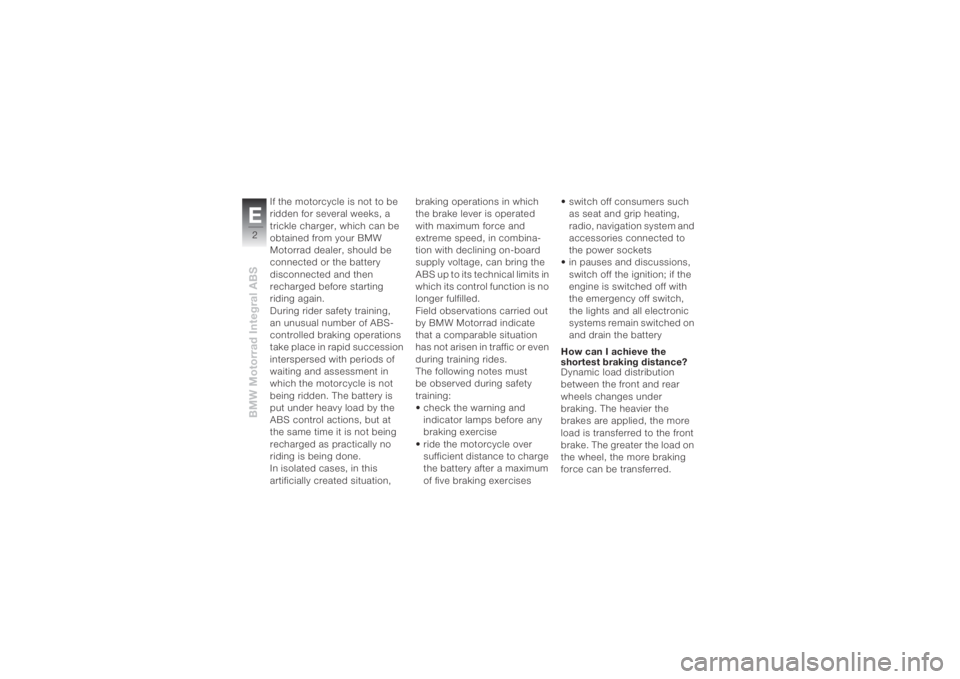
BMW Motorrad Integral ABSE2
If the motorcycle is not to be
ridden for several weeks, a
trickle charger, which can be
obtained from your BMW
Motorrad dealer, should be
connected or the battery
disconnected and then
recharged before starting
riding again.
During rider safety training,
an unusual number of ABS-
controlled braking operations
take place in rapid succession
interspersed with periods of
waiting and assessment in
which the motorcycle is not
being ridden. The battery is
put under heavy load by the
ABS control actions, but at
the same time it is not being
recharged as practically no
riding is being done.
In isolated cases, in this
artificially created situation, braking operations in which
the brake lever is operated
with maximum force and
extreme speed, in combina-
tion with declining on-board
supply voltage, can bring the
ABS up to its technical limits in
which its control function is no
longer fulfilled.
Field observations carried out
by BMW Motorrad indicate
that a comparable situation
has not arisen in traffic or even
during training rides.
The following notes must
be observed during safety
training:
• check the warning and
indicator lamps before any
braking exercise
• ride the motorcycle over
sufficient distance to charge
the battery after a maximum
of five braking exercises• switch off consumers such
as seat and grip heating,
radio, navigation system and
accessories connected to
the power sockets
• in pauses and discussions,
switch off the ignition; if the
engine is switched off with
the emergency off switch,
the lights and all electronic
systems remain switched on
and drain the battery
How can I achieve the
shortest braking distance?
Dynamic load distribution
between the front and rear
wheels changes under
braking. The heavier the
brakes are applied, the more
load is transferred to the front
brake. The greater the load on
the wheel, the more braking
force can be transferred.Info_I_ABS_en_xx.fm Seite 2 Dienstag, 19. Juli 2005 2:48 14
Page:
< prev 1-8 9-16 17-24